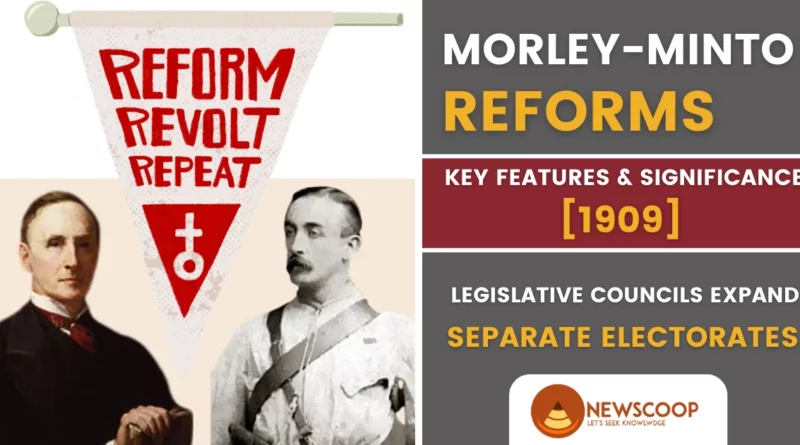Morley-Minto Reforms: Key Features & Significance | UPSC
The Morley-Minto reforms were a series of constitutional changes introduced by the British colonial government in India in 1909. These reforms aimed to increase Indian participation in the governance of the country while still preserving British control.
The reforms were significant because they represented the first attempt by the British to include Indians in the decision-making process and were a significant step towards Indian self-rule.
Historical Context
India was ruled by the British East India Company from 1757 until the Indian Rebellion of 1857, after which it became a colony of the British Crown. British colonial rule was characterized by economic exploitation, political control, and cultural domination.
India’s resources were used to fuel Britain’s industrial revolution, and Indian industries were deliberately suppressed to maintain British economic dominance. British officials held all important positions in government, and Indians were largely excluded from political participation.
The early nationalist movements, led by figures such as Dadabhai Naoroji, Bal Gangadhar Tilak, and Lala Lajpat Rai, were a response to this political and economic oppression. The Indian National Congress, founded in 1885, was the first organization to unite the various nationalist groups and push for Indian self-rule.
| Information | Details |
|---|---|
| Date of Introduction | 1909 |
| Key Features | Expansion of Legislative Councils Introduction of Communal Representation Increased Provincial Autonomy |
| Scope of the Reforms | Limited |
| Representation in Executive | Limited |
| Franchise | Restricted |
| Significance | First attempt by the British to include Indians in the decision-making process; marked a turning point in the history of Indian politics |
Who were Morley and Minto?
John Morley was a British statesman who served as Secretary of State for India from 1905 to 1910. He was a liberal politician who believed in the need for reform in India and was responsible for introducing the Morley-Minto reforms.
Gilbert Elliot-Murray-Kynynmound, 4th Earl of Minto, was the Viceroy of India from 1905 to 1910. He worked closely with Morley in introducing the reforms and was supportive of greater Indian participation in the governance of the country.
What were the Morley-Minto reforms?
The Morley-Minto reforms introduced several changes to the Indian political system, including:
- Expansion of Legislative Councils: The reforms expanded the Legislative Councils and gave Indians a greater role in the legislative process. The number of members in the Imperial Legislative Council was increased from 16 to 60, with 27 of those seats reserved for Indians.
- Communal Representation: The reforms introduced the concept of communal representation, which allowed for separate electorates for Hindus and Muslims. This was a significant change from the previous system, where only the wealthy elite had a say in government. Communal representation gave a voice to religious minorities, who had previously been marginalized in the political process.
- Separate Electorates: The reforms introduced separate electorates for Muslims, which meant that Muslims would be represented by their own elected officials in the Legislative Councils. This was intended to give Muslims greater representation in government and address their concerns about being marginalized in a predominantly Hindu country.
- Increased Provincial Autonomy: The reforms also increased provincial autonomy, giving elected Indian officials greater control over local affairs.
When were the Reforms Introduced?
The Morley-Minto reforms were introduced in 1909 by the British colonial government in India. The reforms were implemented gradually, with some changes taking effect immediately and others being phased in over time. The reforms represented a significant shift in British attitudes towards Indian participation in government and laid the groundwork for future constitutional reforms that would eventually lead to Indian independence.
Key Features of the Morley-Minto Reforms
The following are the key features of the Morley-Minto reforms, presented one by one in points:
1. Expansion of Legislative Councils
The Morley-Minto reforms expanded the Legislative Councils and increased Indian participation in the decision-making process. The number of members in the Imperial Legislative Council was increased from 16 to 60, with 27 of those seats reserved for Indians.
2. Communal Representation
The reforms introduced the concept of communal representation, which allowed for separate electorates for Hindus and Muslims. This was a significant change from the previous system, where only the wealthy elite had a say in government. Communal representation gave a voice to religious minorities, who had previously been marginalized in the political process.
3. Separate Electorates
The Morley-Minto reforms introduced separate electorates for Muslims, which meant that Muslims would be represented by their own elected officials in the Legislative Councils. This was intended to give Muslims greater representation in government and address their concerns about being marginalized in a predominantly Hindu country.
4. Increased Provincial Autonomy
The reforms increased provincial autonomy, giving elected Indian officials greater control over local affairs. This helped to decentralize power and gave Indians more say in how their local governments were run.
5. Restricted Franchise
The Morley-Minto reforms did not extend the right to vote to all Indians. Instead, the franchise was restricted to those who met certain property qualifications. This meant that only a small percentage of the population was eligible to vote and participate in the political process.
6. Limited Executive Council Representation
While the reforms increased Indian participation in the Legislative Councils, they did not increase Indian representation in the Executive Councils, which held more power than the Legislative Councils. The Executive Councils remained dominated by British officials.
Reactions to the Morley-Minto Reforms
1. Responses from Indian Nationalists
- Indian nationalists had mixed reactions to the Morley-Minto reforms.
- While some welcomed the reforms as a step in the right direction towards greater Indian participation in government, others criticized them as being too limited and not going far enough in granting Indians full political rights and self-rule.
- Some nationalists also saw the introduction of communal representation as a divisive tactic used by the British to pit Hindus and Muslims against each other.
2. Criticism from British Officials
- While some British officials supported the Morley-Minto reforms, others were critical of them.
- Some officials believed that the reforms went too far in granting Indians a greater role in government and that they would ultimately lead to Indian independence.
- Others were critical of the concept of communal representation, seeing it as a threat to the unity of the Indian nation.
3. Impact on Indian Society & Politics
- The Morley-Minto reforms had a significant impact on Indian society and politics.
- They marked the first attempt by the British to include Indians in the decision-making process and were a significant step towards Indian self-rule.
- The expansion of the Legislative Councils and the introduction of communal representation gave a voice to religious minorities and increased Indian participation in government.
- However, the restrictions on the franchise and the limited representation in the Executive Councils meant that the reforms did not go far enough in granting Indians full political rights.
The reforms also had a significant impact on the nationalist movement in India. While some nationalists saw them as a step in the right direction, others saw them as insufficient and continued to push for full political rights and self-rule. The reforms also contributed to the growing rift between Hindus and Muslims, as communal representation gave each group a separate political identity.
Significance of the Morley-Minto Reforms
The Morley-Minto reforms were significant for several reasons:
First, they marked the first significant step towards Indian participation in the decision-making process of their country. Before the reforms, Indians had limited access to government and were largely excluded from political participation. The reforms expanded the Legislative Councils and gave Indians a greater role in the legislative process.
Second, the reforms introduced the concept of communal representation, which allowed for separate electorates for Hindus and Muslims. This was a significant change from the previous system, where only the wealthy elite had a say in government. Communal representation gave a voice to religious minorities, who had previously been marginalized in the political process.
Finally, the reforms were significant because they represented a shift in British attitudes toward Indian self-rule. The British had previously been reluctant to grant Indians any real political power, but the Morley-Minto reforms signaled a willingness to consider Indian demands for greater autonomy.
Conclusion
In conclusion, the Morley-Minto reforms were a significant moment in the history of British colonial rule in India. They marked the first attempt by the British to include Indians in the decision-making process and were a significant step towards Indian self-rule.
The expansion of the Legislative Councils and the introduction of communal representation gave a voice to religious minorities and increased Indian participation in government. However, the restrictions on the franchise and the limited representation in the Executive Councils meant that the reforms did not go far enough in granting Indians full political rights.
The reforms had a significant impact on Indian society and politics, raising Indian expectations for greater political rights and self-rule and contributing to the growth of the nationalist movement. Their legacy can be seen in later constitutional reforms in India, which were built upon the foundation laid by the Morley-Minto reforms.
Overall, the Morley-Minto reforms were an important step towards Indian self-rule and a significant moment in the history of Indian politics. They represent a complex chapter in the history of British colonialism in India, with both positive and negative implications for the future of the country.
Thank You!

